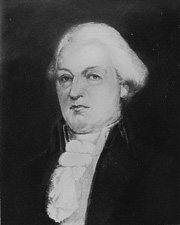Theodorus Bailey (politician)
Theodorus Bailey | |
|---|---|
 | |
| United States Senator from New York | |
| In office March 4, 1803 – January 16, 1804 | |
| Preceded by | Gouverneur Morris |
| Succeeded by | John Armstrong, Jr. |
| Member of the U.S. House of Representatives from New York's 5th district | |
| In office March 4, 1793 – March 3, 1797 | |
| Preceded by | Peter Silvester |
| Succeeded by | David Brooks |
| In office March 4, 1799 – March 3, 1801 | |
| Preceded by | David Brooks |
| Succeeded by | Thomas Tillotson |
| In office December 7, 1801 – March 3, 1803 | |
| Preceded by | Thomas Tillotson |
| Succeeded by | Andrew McCord |
| Personal details | |
| Born | October 12, 1758 Fishkill, New York |
| Died | September 6, 1828 (aged 69) New York City, New York |
| Political party | Anti-Administration, Democratic-Republican |
| Profession | lawyer, politician |
| Military service | |
| Branch/service | New York Militia |
| Battles/wars | American Revolution |
Theodorus Bailey (October 12, 1758 – September 6, 1828) was an American lawyer and politician from Poughkeepsie, New York, who represented New York in both the U.S. House and Senate.
Biography
Bailey was born near Fishkill, New York on October 12, 1758 where he attended the rural schools and studied law. He was admitted to the bar in 1778 and commenced practice in Poughkeepsie, New York. He served with the New York Militia during the Revolutionary War. He also served in the State militia from 1786 until 1805 and attained the rank of brigadier general.[1]
Bailey ran for Congress in March 1789, but was defeated by Federalist Egbert Benson. Bailey was elected as a Democratic-Republican to the 3rd and the 4th United States Congresses, serving from March 4, 1793, to March 3, 1797. He was elected again to the 6th United States Congress, serving from March 4, 1799, to March 3, 1801. In April 1801, he was elected to the New York State Assembly, but vacated his seat before the State Legislature convened, because he was elected to the 7th United States Congress to fill the vacancy caused by the resignation of Thomas Tillotson, and served from December 7, 1801, to March 3, 1803.
In 1803, Bailey was elected a U.S. Senator from New York, and served from March 4, 1803, to January 16, 1804,[2] when he resigned to accept the position of Postmaster of New York City, which he held until his death.
Death
Bailey died in New York, New York County, New York, on September 6, 1828 (age 69 years, 330 days). He was interred at Dutch Burying Ground, Manhattan, New York; and was reintered on January 8, 1864, at Poughkeepsie Rural Cemetery, Poughkeepsie, New York.[3]
References
- ^ "Theodorus Bailey". Biographical Directory of the United States Congress. Retrieved 10 August 2013.
- ^ "Theodorus Bailey". Govtrack US Congress. Retrieved 10 August 2013.
- ^ "Theodorus Bailey". The political Graveyard. Retrieved 10 August 2013.
External links
- United States Congress. "Theodorus Bailey (id: B000049)". Biographical Directory of the United States Congress.
- Find A Grave
- 1758 births
- 1828 deaths
- Members of the United States House of Representatives from New York
- United States Senators from New York
- Members of the New York State Assembly
- People from New York City
- People from Poughkeepsie, New York
- New York Democratic-Republicans
- Democratic-Republican Party United States Senators
- United States militia in the American Revolution
- Burials at Poughkeepsie Rural Cemetery
- Democratic-Republican Party members of the United States House of Representatives
- Postmasters of New York City

